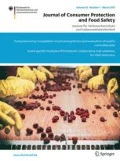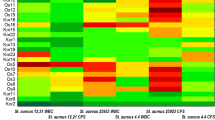Abstract
In this study three different food preservatives (sodium nitrate, sodium benzoate and sodium sorbate) were used to evaluate their effect on two enterotoxicogenic strains (Bacillus cereus GT1 and Staphylococcus aureus S1). A significant decrease in the viability and production of virulence factors was observed. Yet, obvious tolerance to increasing concentrations (from 1 to 6 g/l) of the three preservatives was recorded reflecting possible resistance mechanisms within the tested strains. The two strains were subjected to increasing doses of gamma radiation (1, 2, 3, 4, 5, 6, 7, 8, 9 and 10 kGy). Obvious correlation was observed between the initial counts of bacterial spores contaminating the products and the required dose for their complete elimination. Whereas the eliminating dose of B. cereus GT1 strain was 10 kGy only 4 kGy was sufficient to suppress the growth and virulence of S. aureus S1, reflecting its sensitivity to low doses of gamma irradiation. Also, inhibition of the two strains by probiotic strain Bacillus pumilus G4 was studied both in situ (in cheese) and in vitro (in culture media). The viable cell population of B. cereus GT1 increased from 106 to 2.9 × 108 CFU/g within 60 h in controls but decreased from 2.1 × 106 to 2.3 × 103 CFU/g after treatment with the probiotic strain. No viable count was observed after 60 h of incubation. Whereas, the viable cell population of S. aureus S1 increased from 106 to 2.5 × 108 CFU/g within 60 h in controls but decreased from 1.5 × 106 to 4.3 × 102 CFU/g after treatment with the probiotic strain. No viable count was observed after 54 h of incubation.




Similar content being viewed by others
References
Abdou MA, Awny NM, Abou Zeid AA (2011) Prevalence of toxicogenic bacteria in some foods and detection of Bacillus cereus and Staphylococcus aureus enterotoxins genes using multiplex PCR. Ann Microbiol. doi:10.1007/s13213-011-0293-7
Antoni I (1973) The effect of ionizing radiation on some molecules of biological importance. Technical reports series. Manual on radiation sterilization of medical and biological material, vol 149. Int Atomic energy agency, Vienna
Aunpad R, Bangchang K (2007) Pumilicin 4, a novel bacteriocin with anti-MRSA and anti-VRE activity produced by newly isolated bacteria Bacillus pumilus strain WAPB4. Curr Microbial 55(4):308–313
Baird-Parker AC (1980) Organic acids. In: Microbial ecology of foods, vol. I. Factors affecting life and death of microorganisms by ICMSF, Academic press, New York, p 126
Brand JM, Bracke JW, Markovetz AJ, Wood DL, Browne LE (1975) Production of verbenol pheromone by a bacterium isolated from black beetles. Nature 254:136–137
Campos CA, Alzamora SM, Gerschenson LN (1998) Inhibitory action of potassium sorbate degradation products against Staphylococcus aureus growth in laboratory medium. Int J Food Microbiol 54:117–122
Chichester DF, Tanner FW (1975) Antimicrobial food additives. In: Furis IE (ed) Hand book of food additives, 2nd edn. CRC Press, Inc. New York, p 115
Claus D, Berkeley R (1986) Endospore forming Gram positive rods and cocci genus Bacillus. In: Senath PhA (ed) Bergey’s manual of systematic bacteriology, 2nd edn, vol 2. Williams and Wilkins, Baltimore, MD, pp 1104–1139
De Buyser ML, Dufour B, Maire M, Lafarge V (2001) Implication of milk and milk products in food-borne diseases in France and in different industrialised countries. Int J Food Microbiol 67:1–17
den Besten HMW, Mataragas M, Moezelaar R, Abee T, Zwietering MH (2006) Quantification of the effects of salt stress and physiological state on thermotolerance of Bacillus cereus ATCC 10987 and ATCC 14579. Appl Environ Microbiol 72(9):5884–5894
Duc LH, Hong HA, Barbosa TM, Henriques AO, Cutting SM (2004) Characterization of Bacillus probiotics available for human use. Appl Environ Microbiol 70(4):2161–2171
El-Sherbeny GA (1982) Studies on the effect of Gamma radiation on growth and metabolism of some fungi isolated from air, vol 196. M.Sc. Thesis, Department of Botany, Faculty of Science, Zagazig University, Egypt, pp 181–191
FDA (2000) Sodium diacetate, sodium acetate, sodium lactate and potassium lactate. Use as food additives. Food and Drug Administration, vol 65, Washington, D.C. Fed Reg, pp 17128–17129
Fravel DR, Spurr HW (1977) Biocontrol of tobacco brown spot disease by Bacillus cereus subsp. mycoides in a controlled environment. Phytopathol 67:930–932
Frazier WC, Westhoff DC (1978) Food microbiology, 3rd edn. Tata MC Graw-hill publishing Co Ltd, New Delhi
Goodlow RJ, Johnson CW, Shafer MV (1947) The antagonistic effect of Bacillus cereus. J Bacteriol 54:268–269
Green WA, Gano AM, Smith KL, Hogan JS, Todhunter DA (1991) Comparison of probiotic and antibiotic intramammary therapy of cattle with elevated somatic cell counts. J Dairy Sci 74:2976–2981
Grewal PS, Hand P (1992) Effects of bacteria isolated from a saprophagous rhabditid nematode Caenorhabditis elegans on the mycelial growth of Agaricus bisporus. J App Bacteriol 72:173–179
Hanis T, Mnukova J, Jelen P, Klir P, Perez B, Pesek M (1988) Effect of irradiation on survival of natural microflora and some nutrients in cereal meals. Cereal Chemist J 65(5):381–383
Haugmo SE (2001) Microbiological control of raw cow and goat milk used in unpasteurized production. M.S. Thesis. Norwegian University of Science and Technology, Trondheim, Norway
Headrick ML, Korangy S, Bean NH, Angulo FJ, Altekruse SF, Potter ME, Klontz KC (1998) The epidemiology of raw milk-associated foodborne disease outbreaks reported in the United States, 1973 through 1992. Am J Public Health 88:1219–1221
Hewedy MA (1983) Studies on the effect of radiation, heat and freezing on certain microorganisms. M.Sc. Thesis Department of Botany, Ain Shams University of girls, Cairo, Egypt
Hong HA, Duc LH, Cutting SM (2006) The use of bacterial spore formers as probiotics. FEMS Microbial Rev 29:813–835
Hudson JA (1994) Comparison of response surface models for listeria monocytogenes strains under aerobic conditions. Food Res Int 27:53–59
Ingram M, Farkas J (1977) Microbiology safety of foods pasteurized by ionizing radiation. Acta Aliment 6:123–185
Jorgensen HJ, Mork T, Hogasen HR, Rorvik LM (2005) Enterotoxigenic Staphylococcus aureus in bulk milk in Norway. J Appl Microbiol 99:158–166
LaRocco AK, Martin ES (1981) Effects of potassium sorbate alone and in combination with sodium chloride on the growth of Salmonella typhimurium 7136. J Food Sci 46:568–570
Luck E (1990) Food applications of sorbic acid and its salts. Food Addit Contam 7:711–715
Luck E, Jager M (1995) Antimicrobial food additives, characteristics, uses, effects. Springer, Berlin
Mami A, Henni JE, Kihal M (2008) Antimicrobial activity of Lactobacillus species isolated from Algerian raw goat’s milk against Staphylococcus aureus. World J Dairy Food Sci 3(2):39–49
Mikesell P, Invis BE, Ristroph JD, Dreier TM (1983) Evidence for plasmid-mediated toxin production in Bacillus anthracis. Infect Immune 39:371–376
Misra AK, Kuila RK (1992) Use of Bifidobacterium bifidum in the manufacture of bifidus milk and its antibacterial activity. Lait 72(2):213–220
Nista EC, Candelli M, Cremonini F, Cazzato IA, Zocco M et al. (2004) Bacillus clausii therapy to reduce side-effects of anti-helicobacter pylori treatment: randomized, double-blind, placebo controlled trail. Aliment Pharmacol Ther 20(10):1181–1188
Nowroozi J, Mirzaii M (2004) Study of Lactobacillus as probiotic bacteria. Irainian J Public Health 33(2):1–7
Paik HD, Bae SS, Park SH, Pan JG (1997) Identification and partial characterization of tochicin, a bacteriocin produced by Bacillus thuringiensis subsp. tochigiensis. J Int Microbiol Biotechnol 19:294–298
Reid G (2001) Probiotic agents to protect urogenital tract against infection. Am J Clin Nutr 77:437–443
Schiemann DA (1978) Occurrence of Bacillus cereus and the bacteriological quality of Chinese take-out foods. J Food Prot 41:450–454
Sofos JN, Busta FF (1980) Antimicrobial activity of sorbates. J Food Prot 44:614–622
Sofos JN, Pierson MD, Blocher JC, Busta FE (1986) Mode of action of sorbic acid on bacterial cells and spores. Int J Food Microbiol 3:1–7
Spotts Whitney EA, Beatty ME, Taylor TH, Weyant R, Sobel J, Arduino MJ, Ashford DA (2003) Inactivation of Bacillus anthracis spores. Emerg Infect Dis 9:623–627
Stabb EV, Jacobson LM, Handelsman J (1994) Zwittermicin A-producing strains of Bacillus cereus from diverse soils. Appl Environ Microbial 60:4404–4412
Tagg JR, Dierksen KP (2003) Bacterial replacement therapy: adapting ‘germ warfare’ to infection prevention. Trends Biotechnol 21:217–223
Tham WA, Hajdu LJ, Danielsson-Tham ML (1990) Bacteriological quality of on-farm manufactured goat cheese. Epidemiol Infect 104:87–100
Zottola EA, Smith LB (1993) Growth and survival of undesirable bacteria in cheese. In: Fox PF (ed) Cheese: chemistry, physics and microbiology. Chapman and Hall, London, UK, pp 471–492
Author information
Authors and Affiliations
Corresponding author
Rights and permissions
About this article
Cite this article
Abdou, M.A., Awny, N.M. & Abou Zeid, A.A. Inhibition of enterotoxicogenic strains Bacillus cereus GT1 and Staphylococcus aureus S1 isolated from double white cream cheese. J. Verbr. Lebensm. 7, 221–228 (2012). https://doi.org/10.1007/s00003-012-0772-1
Received:
Accepted:
Published:
Issue Date:
DOI: https://doi.org/10.1007/s00003-012-0772-1




